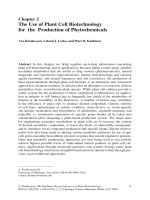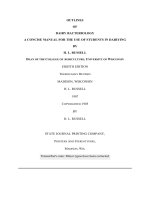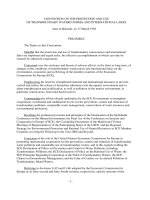The Use of Plant Cell Biotechnology for the Production of Phytochemicals
Bạn đang xem bản rút gọn của tài liệu. Xem và tải ngay bản đầy đủ của tài liệu tại đây (572.76 KB, 19 trang )
Chapter 2
The Use of Plant Cell Biotechnology
for the Production of Phytochemicals
Ara Kirakosyan, Leland J. Cseke, and Peter B. Kaufman
Abstract In this chapter, we bring together up-to-date information concerning
plant cell biotechnology and its applications. Because plants contain many valuable
secondary metabolites that are useful as drug sources (pharmaceuticals), natural
fungicides and insecticides (agrochemicals), natural food flavorings and coloring
agents (nutrition), and natural fragrances and oils (cosmetics), the production of
these phytochemicals through plant cell factories is an alternative and concurrent
approach to chemical synthesis. It also provides an alternative to extraction of these
metabolites from overcollected plant species. While plant cell cultures provide a
viable system for the production of these compounds in laboratories, its applica-
tion in industry is still limited due to frequently low yields of the metabolites of
interest or the feasibility of the bioprocess. A number of factors may contribute
to the efficiency of plant cells to produce desired compounds. Genetic stability
of cell lines, optimization of culture condition, tissue-diverse vs. tissue-specific
site-specific localization and biosynthesis of metabolites, organelle targeting, and
inducible vs. constitutive expression of specific genes should all be taken into
consideration when designing a plant-based production system. The major aims
for engineering secondary metabolism in plant cells are to increase the content
of desired secondary compounds, to lower the levels of undesirable compounds,
and to introduce novel compound production into specific plants. Recent achieve-
ments have also been made in altering various metabolic pathways by use of spe-
cific genes encoding biosynthetic enzymes or genes that encode regulatory proteins.
Gene and metabolic engineering approaches are now being used to successfully
achieve highest possible levels of value-added natural products in plant cell cul-
tures. Applications through functional genomics and systems biology make plant
cell biotechnology much more straightforward and more attractive than through pre-
vious, more traditional approaches.
A. Kirakosyan (
B
)
University of Michigan, Ann Arbor, MI 48109-0646, USA
e-mail:
15
A. Kirakosyan, P.B. Kaufman, Recent Advances in Plant Biotechnology,
DOI 10.1007/978-1-4419-0194-1_2,
C
Springer Science+Business Media, LLC 2009
16 A. Kirakosyan et al.
2.1 Plant Cell Factories as a Source of High-Value Metabolites
The presence of valuable metabolites in plants has stimulated interest on the part
of industry in the fields of pharmaceuticals (as drug sources), agrochemicals (for
the supply of natural fungicides and insecticides), nutrition (for the acquisition of
natural substances used for flavoring and coloring foods), and cosmetics (natural
fragrances and oils). The bulk of the market products, such as secondary metabo-
lites from higher plants, are collected from plants growing in the wild or from field-
cultivated sources. In using a plant strategy, major issues are that these plants need a
seasonal period of growth before harvesting is possible. Other issues here include a
relatively short growing seasons in temperate regions, disease and insect predation,
and high costs for labor and machinery. On the other hand, total chemical synthesis
of several compounds is possible, but economically not feasible. Therefore, an alter-
native, economically viable, and environmentally sustainable production source for
desired secondary metabolites is of great interest. In this regard, plant cell cultures
can be an attractive alternative as a production system, as well as a model system,
to study the regulation of natural product biosynthesis in plants so as to ultimately
increase yields.
The commercial-scale use of plant cell cultures is now progressing rapidly
despite many drawbacks and limitations that scientists have acknowledged. Earlier,
Verpoorte et al. (1994) had shown that biotechnological application of plant cell
cultures on a large scale may become economically feasible. The limitation here,
however, concerns the high price of the final product. This is mainly attributed to
the slow growth of plant cell cultures, making the depreciation costs of the bioreac-
tor a major cost-determining factor in future attempts (Verpoorte et al., 1994).
The detailed monitoring of functional status of cells is now routinely per-
formed for plant cell cultures in order to permit accurate assessment of growth and
metabolite production rates. The availability of plant cells for quantitative measure-
ment parameters makes possible the accurate assessment of a culture’s status and
places the analysis of cell cultures on a par with the detailed monitoring that has
been successfully applied for commercial microbial fermentations. The collected
information may enable identification and clearer understanding of the biological
and chemical constraints within the process, as well as optimization of cell culture
production, planning, costs, and scheduling activities. All of these factors are now
considered in relation to scale, geometry, and configuration of the bioreactor. In
addition, in vitro plant cell cultures are currently carried out for a diverse range of
bioreactor designs, ranging from batch, airlift, and stirred tank to perfusion and con-
tinuous flow systems. For a small scale of operation, both the conventional and the
novel bioreactor designs are relatively easy to operate. In contrast, for a larger scale
of operation, problems of maintaining bioreactor sterility and providing an adequate
oxygen supply to the cells have yet to be resolved (Vogel and Tadaro, 1997).
While industrial applications of plant cell cultures are still in progress, recently,
some promising advances have already been achieved for the production of several
high-value secondary metabolites through cell cultivation in bioreactors. For exam-
ple the valuable progress has been achieved for paclitaxel (Taxol), where yields have
2 Use of Plant Cell Biotechnology 17
improved more than 100-fold using multifactorial screening strategy (Roberts and
Shuler, 1997). Such progress, however, is not universal and many trials with differ-
ent cell cultures initially failed to produce high levels of the desired products. The
failure to produce high levels of desired metabolites by cell factories is still due to
our insufficient knowledge as to how plants regulate metabolite biosynthesis.
Earlier, Zenk and coworkers (1997) suggested a strategy to improve the pro-
duction of secondary metabolites in cell cultures that is now being used by many
researchers. This strategy includes the following general steps: (1) plant screening
for secondary metabolite accumulation; (2) use of high producer plants for initia-
tion of callus cultures; (3) biochemical analysis of derived cultures for their vari-
ability and productivity; (4) establishment of cell suspension cultures; (5) analysis
of metabolite levels in cell suspension cultures; (6) selection of cell lines based on
single cells; (7) analysis of culture stability; and (8) further improvement of product
yields.
How does this strategy work and does it raise the bars of current modern plant
biotechnology? Here, we will trace in detail the main points of such a strategy in
order to show how these steps may work and what limitations may still occur when
they are employed in modern plant biotechnology. As a part of such strategy, the
primary effort has been devoted to the development of cultures from elite germplasm
so as to take advantage of the wide range of biosynthetic capacities within cultures.
This has been achieved either by selection or by screening germplasm for highly
productive cell lines, as for example, in production of Taxol from Taxus cell cultures
(Kim et al., 2005). On the other hand, several limiting factors can play crucial role
for successful use of plant cell cultures in biotechnology. These limiting factors can
include light intensity and quality; temperature; length of culture period, including
kinetics of production; concentration and source of major limiting nutrients such as
phosphate, carbon, and nitrogen; and concentration and source of micronutrients,
vitamins, and plant growth regulators.
The other point concerns optimization of cell culture conditions. This has been
carried out for a variety of media formulations and environmental conditions. The
Plackett and Burman technique was particularly useful in these cases. It allows
for testing of multiple variables within a single experiment (Plackett and Burman,
1946). This method relies on the following characteristics: (1) each variable is tested
at a high level in half of the test cultures, or at a low level or not at all in the other
half; (2) any two variables are tested in 25% of the test cultures; (3) both will be
excluded in 25%; and (4) only one variable is tested in the remaining 50% of the test
cultures. Since the production of secondary metabolites can be followed by HPLC
or GC, a medium can be selected that supports good cell growth and production
of secondary metabolites. The role of the cell cycle in plant secondary metabolite
production must also be considered.
Screening of cell cultures for metabolite high productivity is carried out on sev-
eral levels. In some cases, high-producing cell clones are obtained from single cells,
and subsequently, these are used for screening high-producing strains. For rapid
selection of high-producing cells, some simple techniques are applicable. A good
example is flow cytometry, which may be useful. This technique is based on the fact
18 A. Kirakosyan et al.
that cells contain fluorescent products (e.g., thiophenes), and therefore, it is possible
to separate these (marked) cells from others. However, some problems may occur
with cell line stability, especially as a result of cell differentiation or morphogene-
sis. Therefore, such stability problems of cell lines have probably made researchers
reluctant to develop extensive screening programs, leaving this as the last step prior
to an industrial application (Verpoorte, 1996). The fluorescent proteins from a wide
variety of marine organisms have initiated a revolution in the study of cell behavior
by providing convenient markers for gene expression and protein targeting in living
cells and organisms. The most widely used of these fluorescent proteins, the green
fluorescent protein (GFP), first isolated from the jellyfish Aequorea victoria, can be
attached to virtually any protein of interest and still fold into a fluorescent molecule.
Fluorescent proteins are increasingly being employed as noninvasive probes in liv-
ing cells due to their ability to be genetically fused to proteins of interest for investi-
gations of localization, transport, and dynamics. Martin Chalfie, Osamu Shimomura,
and Roger Y. Tsien share the 2008 Nobel Prize in Chemistry for their discovery and
development of molecular probe uses of the green fluorescent protein. To date, many
plant cells, along with other organisms, have been selected using GFP as a marker
for gene expression.
Alternatively, selection of high-producing cell lines by culturing cells on media
containing certain additives, such as biosynthetic precursors or toxic analogues, also
may be applied (Verpoorte, 1996). In this case, some instability of many precursors
or toxic effects of some constituents on the cells is, however, possible. Therefore, it
is not possible to use a universal screening platform for plant cell cultures. Instead,
a specific screening for a particular plant cell culture must be employed in order to
produce specifically desired metabolites.
Whether with plant cell cultures or with intact plants, the key to success in dis-
covering naturally occurring phytochemicals rests on bioassay-guided fractionation
and purification procedures. Generally, screening of both natural products and syn-
thetic organic compounds has led to impressive advances in the identification of
active agents. High-throughput screens and sensitive instrumentation for structural
elucidation have greatly reduced the amount of time and the sample quantity that
are required for analysis.
Still, the main criterion for future biotechnological success is connected to the
biosynthetic capacity of cell factories. It is well known that the biosynthesis of
plant secondary metabolites could be up- or downregulated by biotic and abiotic
factors. In order to unravel the regulation of plant metabolism by such environmen-
tal stimuli, it is important to elucidate the factors that control the accumulation of
secondary metabolites in plants. Therefore, nowadays, scientists are carrying out
intensive research efforts to identify and apply limiting factors that can ultimately
increase plant cells’ biosynthetic capacities. With such research, attention has also
been given to the accumulation and storage of desired secondary metabolites in
plant cells. Secondary metabolites in plants, and perhaps in tissue cultures, are
usually stored intracellularly, as for example, in vacuoles or multicellular cavities.
Thus, transporters probably play an important role in the sequestration of secondary
metabolites (Kunze et al., 2002).
2 Use of Plant Cell Biotechnology 19
Biotic factors are among the environmental factors that affect to a large extent
the production of phytochemicals. Therefore, it is highly probable that there is a
relationship with defensive responses that is manifested either in phytoalexin pro-
duction or in the production of compounds produced along one of the signal trans-
duction pathways. An approach to characterize the biotic parameters that may elicit
the plant’s defensive mechanisms may be revealed by an analysis of the expression
of certain genes involved in the process and by correlation of gene induction with
particular metabolite levels.
In addition to the strategy described above, new approaches based on genetic
and metabolic engineering have been successfully introduced (Verpoorte and
Alfermann, 2000). Consequently, the development of an information base on
genetic, cellular, and molecular levels is now a prerequisite for the use of plants
or plant cell cultures for biotechnological applications for the following reasons.
First, a better understanding of the basic metabolic processes involved could provide
key information needed to produce high-value metabolites. Second, many biosyn-
thetic pathways in plants are extensive and complicated, requiring multiple enzy-
matic steps to produce the desired end-product. So, when engineering secondary
metabolism in plant cells, the primary aim should be to increase the content of
desired secondary compounds, to lower the levels of undesirable compounds, and
finally to introduce novel compound production into specific plants. This kind of
research must, therefore, focus on metabolic regulation by first establishing the path-
ways at the level of intermediates and enzymes that catalyze secondary metabolite
formation (metabolic pathways profiling). The subsequent step is the selection of
targets for further studies at the level of genes, enzymes, and compartments. Such
studies on regulation of metabolite biosynthesis might eventually lead to the deriva-
tion of transgenic plants or plant cell cultures with an improved productivity of
the desired compounds. Aside from practical applications with such organisms,
the knowledge gained will be of interest in connection with studies on the adap-
tive/functional roles of secondary metabolism in plants. These are covered in the
next section that deals with functional genomics.
2.2 Applications Through the Use of Functional Genomics
Interdisciplinary approaches that are based on molecular biology and biochemistry
led to rapid advances in the identification of biosynthetic genes, the elucidation of
specific biosynthetic enzymes, and the identification of end-products. The complete
genetic makeup of an organism has been generated in the plant sciences as well.
Because of the success of large-scale quantitative biology projects such as genome
sequencing (genomics), the suffix “omics” has been extended to other directions.
Proteomics is now well-established as a term that refers to a study of the pro-
teome. More recently, metabolomics has been introduced, which is now leading to
an incredible amount of research on all kinds of primary and secondary metabolites
(Cseke et al., 2006). Thus, quantitative and qualitative measurements of all kinds
of cellular metabolites, or metabolomics, yield a global view of the biochemical
20 A. Kirakosyan et al.
phenotype or phytochemical database for a plant organism. This can be used to
differentiate phenotypes and genotypes at a metabolite level that may or may not
produce visible phenotypes. Due to the diversity of plant secondary metabolites, it
is generally accepted that there is no single analytical method employed that can
provide sufficient visualization of the entire metabolome. Multiple technologies are
therefore needed to measure the entire metabolome of a given plant sample. Most
metabolomic approaches seek to profile metabolites in a nontargeted way, i.e., to
reliably separate and detect as many metabolites as possible in a single analysis.
This is technically challenging due to the diverse chemical properties and large dif-
ferences in the abundance of the metabolites. In contrast, selective profiling of a
certain group of compounds, which is also called targeted metabolic profiling,is
relatively easy to perform.
One of the major applications of genome sequencing of plants is functional
genomics. In simple words, an understanding of the function of genes and other
parts of the genome is known as functional genomics. It is a field of molecular
biology that attempts to make use of the vast amount of data produced by genomic
projects (such as genome sequencing projects) to describe gene (and protein) func-
tions and their interactions. Unlike genomics and proteomics, functional genomics
focuses on the dynamic aspects, such as gene transcription, translation, and protein–
protein interactions, as opposed to the static aspects of the genomic information such
as DNA sequences or structures (Cseke et al., 2006). It aims to determine the bio-
logical function of every gene within a given genome. Functional genomics, then,
refers to the development and application of global (genome-wide or system-wide)
experimental approaches to assess gene function by making use of the informa-
tion and reagents provided by structural genomics. Functional genomics includes
function-related aspects of the genome itself, such as mutation and polymorphism
analysis, as well as measurement of molecular activities. Together, all measurement
modalities quantify the various biological processes and powers in order to enhance
our understanding of gene, protein, and metabolite functions and their interactions
(Fig. 2.1).
Functional genomics uses mostly modern techniques to characterize the abun-
dance of gene products such as mRNAs and proteins. It is characterized by high-
throughput or large-scale experimental methodologies combined with statistical or
computational analysis of the results. Some typical technology platforms are DNA
microarrays and SAGE (serial analysis of gene expression) for mRNA analysis, two-
dimensional gel electrophoresis and mass spectrometry (MS) for protein analysis,
and targeting and nontargeting mass spectrometry and nuclear magnetic resonance
(NMR) analysis in metabolomics. Because of the large quantity of data produced
by these techniques and the desire to find biologically meaningful patterns, bioin-
formatics is used here for this type of analysis of complex systems. Bioinformat-
ics refers to the extraction of biological information from genomic sequence and
the reconciliation of multiple data sets based on DNA and RNA microarrays. In
connection with the above, a DNA microarray (also called a DNA chip or gene
chip) is a piece of glass or plastic on which pieces of DNA have been affixed in a
microscopic array to screen a biological sample for the presence of many genetic
2 Use of Plant Cell Biotechnology 21
Transcriptomics Metabolomics
Plant Cell Biotechnology Application
Genomics Proteomics
Reconstruction experiment
Using Omics Database for the Selection of Target Genes,
Proteins and Metabolites
Fig. 2.1 Application of
functional genomics tools in
plant cell biotechnology
sequences simultaneously. The affixed DNA segments are known as probes. Thou-
sands of identical probe molecules are affixed at each point in the array in order to
make the chips effective detectors. Many microarrays use PCR products, genomic
DNAs, BACs (bacterial chromosomes), plasmids, or longer oligos (35–70 bases)
instead of short oligonucleotide probes of 25 bases or less. RNA microarrays are
used to detect the presence of mRNAs that may have been transcribed from dif-
ferent genes and that encode different proteins. The RNA is converted to cDNA or
cRNA. The copies may be amplified by RT-PCR (reverse transcriptase-polymerase
chain reaction). Fluorescent tags are enzymatically incorporated into the newly syn-
thesized strands or can be chemically attached to the new strands of DNA or RNA.
A cDNA or cRNA molecule that contains a sequence complementary to one of the
single-stranded probe sequences will hybridize, or stick, via base pairing (more so
for DNA) to the spot at which the complementary probes are affixed. The spot will
then fluoresce, or glow, when examined using a microarray scanner. The major com-
ponents, then, of a functional genomics approach include bioinformatics (the global
assessment of how the expression of all genes in the genome varies under chang-
ing conditions), proteomics (the study of the total protein complement expressed
by a particular cell under particular conditions), and reverse genetics (deducing the
function of novel genes by mutating them and studying mutant phenotypes).
Functional genomics, used as a means of assessing phenotypes, differs from more
classical approaches, primarily with respect to the scale and automation of biologi-
cal investigations. A classical investigation of gene expression might examine how
the expression of a single gene varies with the development of an organism in vivo.
Modern functional genomics approaches, however, can examine how 1,000–10,000
genes are expressed as a function of development.
The massive expansion of available genomic information in plants allows
researchers to push the limits as to what can be produced by a chosen organ-
ism. Such technology continues to hold great promise for the future of plant









